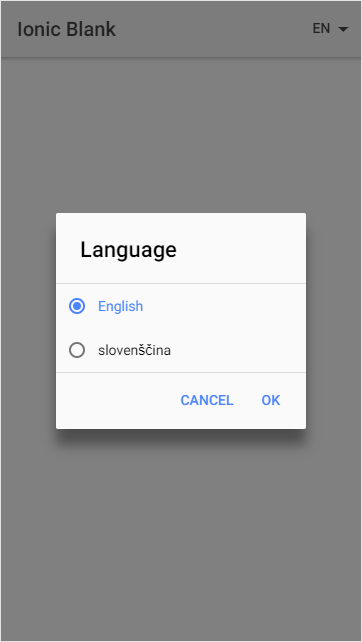Configurable Select Control in Ionic Navbar
There are lots of components included with Ionic framework, but not many of them can be used inside a Navbar.
If you want find an out-of-the box solution for putting a select or a dropdown into the Navbar, you can for example take a look at the standalone Select component, but it wasn't designed to be put into the Navbar.
Fortunately, with some resourcefulness, it's easy enough to create a solution of your own by combining together multiple built-in components.

To create my language selector from the image above, I first created a standard toolbar button. I included a dropdown icon in it, to give it a dropdown appearance:
<ion-header>
<ion-navbar>
<ion-title>
Ionic Blank
</ion-title>
<ion-buttons end>
<button ion-button icon-end (click)="changeLanguage()">
{{language.toUpperCase()}}
<ion-icon name="arrow-dropdown"></ion-icon>
</button>
</ion-buttons>
</ion-navbar>
</ion-header>
On button click, I show the available values to the user in a standard alert dialog with radio inputs:
changeLanguage() {
let alertOptions: AlertOptions = {
title: 'Language',
inputs: [ {
type: 'radio',
label: 'English',
value: 'en',
checked: this.language == 'en'
}, {
type: 'radio',
label: 'slovenščina',
value: 'sl',
checked: this.language == 'sl'
} ],
buttons: [ {
text: 'Cancel'
}, {
text: 'OK',
handler: selectedLanguage => {
this.language = selectedLanguage;
}
} ]
};
this.alertCtrl.create(alertOptions).present();
}
It works great for a mobile application. Probably even better than a regular dropdown menu would.

Of course, there are ways to further improve the solution:
- Instead of hardcoding the available languages in the alert options, you will usually have an array of supported languages as value/label pairs which you can map to the correct input options format.
- You can expand the button handler with the additional logic required to actually change the language in the application.
- To implement localization in the application you should look at the excellent NGX-Translate library.
